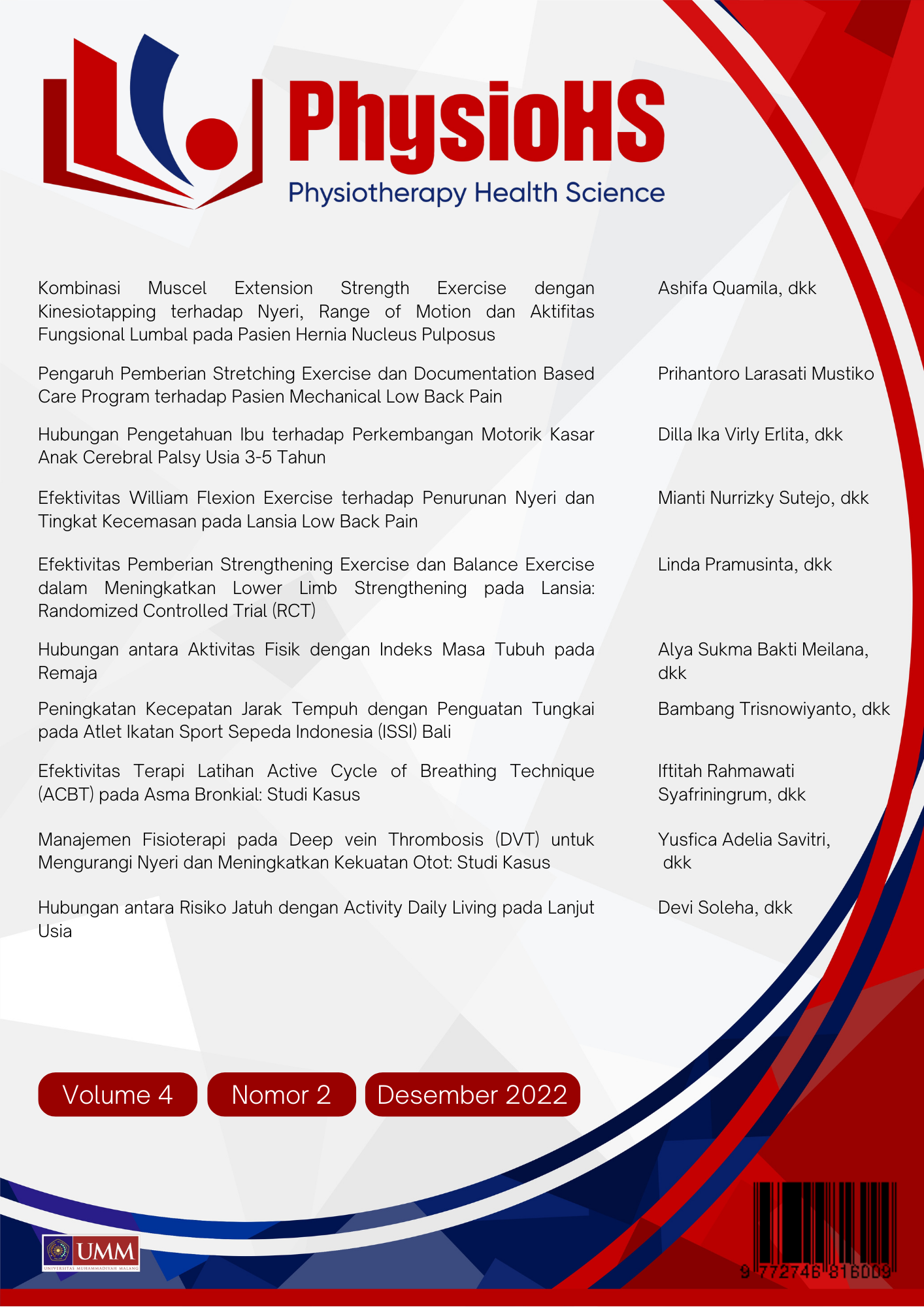Manajemen Fisioterapi pada Deep Vein Thrombosis (DVT) untuk Mengurangi Nyeri dan Meningkatkan Kekuatan Otot: Studi Kasus
DOI:
https://doi.org/10.22219/physiohs.v4i2.22694Keywords:
compression, deep vein thrombosis, icing, rest, stretchingAbstract
Deep vein thrombosis merupakan bekuan darah yang terbentuk pada vena bagian dalam di bawah kulit. Gejala paling umum terjadi di lokasi bekuan darah, diantaranya adalah pembengkakan, kulit terasa hangat dan kemerahan serta nyeri. Penelitian ini menggunakan design single case yang dilakukan sebanyak 4 kali pertemuan dalam 2 minggu, pada Februari 2022, di Rumah Sakit Umum Daerah dr. H. Moh. Anwar, Sumenep, Madura. Penelitian ini bertujuan untuk mengetahui efektifitas manajemen fisioterapi menggunakan metode RICE (Rest, Icing, Compression, Elevation) yang dikombinasikan dengan latihan stretching untuk menangani responden dengan deep vein thrombosis (DVT). Hasil menunjukkan, pada tingkat nyeri diam bernilai 2 menjadi 1, nyeri tekan bernilai 5 menjadi 3, dan nyeri gerak bernilai 3 menjadi 2 Pada kekuatan otot gastrocnemius dan otot soleus dengan nilai 3 menjadi 4. Terjadi penurunan bengkak di atas tuberositas tibia dextra senilai 42 cm menjadi 40,5 cm berkurang sebanyak 1,5 cm, di bawah tuberositas tibia dextra senilai 34 cm menjadi 33 cm berkurang sebanyak 1 cm. Pada pengukuran lingkup gerak sendi (LGS) dari S: 0o -0o-80o meningkat menjadi 0o-0o-100o. Hasil laporan pemberian (Rest, Icing, Compression, Elevation) yang dikombinasikan dengan latihan stretching menunjukkan penurunan nyeri dan peningkatan kekuatan otot meskipun tidak signifikan.
Downloads
References
Algafly, A. A., & George, K. P. (2007). The effect of cryotherapy on nerve conduction velocity, pain threshold and pain tolerance. British Journal of Sports Medicine, 41(6), 365–369. https://doi.org/10.1136/bjsm.2006.031237
Beck, S., Meer, J., & Taylor, T. (2016). Deep vein thrombosis. Emergency Medicine, 48(1), 29–31. https://doi.org/10.12788/emed.2016.0005
Bekerom, M. P. J., Struijs, P. A. A., Blankevoort, L., Welling, L., Van Welling, C. N., & Kerkhoffs, G. M. M. J. (2012). What is the evidence for rest, ice, compression, and elevation therapy in the treatment of ankle sprains in adults? Journal of Athletic Training, 47(4), 435–443. https://doi.org/10.4085/1062-6050-47.4.14
Ciolek, J. J. (1985). Cryotherapy. Review of physiological effects and clinical application. Cleveland Clinic Quarterly, 52(2), 193–201. https://doi.org/10.3949/ccjm.52.2.193
Ernst, E., & Fialka, V. (1994). Ice freezes pain? A review of the clinical effectiveness of analgesic cold therapy. Journal of Pain and Symptom Management, 9(1), 56–59. https://doi.org/10.1016/0885-3924(94)90150-3
Freire, B., Geremia, J., Baroni, B. M., & Vaz, M. A. (2016). Effects of cryotherapy methods on circulatory, metabolic, inflammatory and neural properties: a systematic review. Fisioterapia em Movimento, 29(2), 389–398. https://doi.org/10.1590/0103-5150.029.002.ao18
Harvey, L., Herbert, R., & Crosbie, J. (2002). Does stretching induce lasting increases in joint ROM? A systematic review. Physiotherapy research international : the journal for researchers and clinicians in physical therapy, 7(1), 1–13. https://doi.org/10.1002/pri.236
Hotta, K., Behnke, B. J., Arjmandi, B., Ghosh, P., Chen, B., Brooks, R., … Muller-Delp, J. M. (2018). Daily muscle stretching enhances blood flow, endothelial function, capillarity, vascular volume and connectivity in aged skeletal muscle. Journal of Physiology, 596(10), 1903–1917. https://doi.org/10.1113/JP275459
Kahn, S. R. (1983). The clinical diagnosis of deep venous thrombosis in ambulant patients. Netherlands Journal of Medicine, 26(7), 209–212.
Kesieme, & Kesieme. (2011). Deep vein thrombosis: a clinical review. Journal of Blood Medicine, (April), 59. https://doi.org/10.2147/jbm.s19009
Krabbe, B. (2015). Deep Vein Thrombosis. PanVascular Medicine, Second Edition, 313(20), 4455–4481. https://doi.org/10.1007/978-3-642-37078-6_175
Kruger, P. C., Eikelboom, J. W., Douketis, J. D., & Hankey, G. J. (2019). Deep Vein Thrombosis: update on diagnosis and management. Medical Journal Australia, 11, 2–3. https://doi.org/10.5694/mja2.50201
Kushner, A., West, W. P., & Pillarisetty, L. S. (2020). Virchow Triad Definition / Introduction. StatPearls Publishing LLC, 2–4.
Malanga, G. A., Yan, N., & Stark, J. (2015). Mechanisms and efficacy of heat and cold therapies for musculoskeletal injury. Postgraduate Medicine, 127(1), 57–65. https://doi.org/10.1080/00325481.2015.992719
Mazzolai, L., Aboyans, V., Ageno, W., Agnelli, G., Alatri, A., Bauersachs, R., … Brodmann, M. (2018). Diagnosis and Management of Acute Deep Vein Thrombosis: A Joint Consensus Document From the European Society of Cardiology Working Groups of Aorta and Peripheral Vascular Diseases and Pulmonary Circulation and Right Ventricular Function. European Heart Journal, 39(47), 4208–4218. https://doi.org/10.1093/eurheartj/ehx003
Quinn, M. (2017). Deep Venous Thrombosis. Orthopaedic Physical Therapy Secrets: Third Edition, 49–53. https://doi.org/10.1016/B978-0-323-28683-1.00007-2
Ross, S., & Bn, R. N. (1995). Heparin and Haematoma: Does Ice Make a Difference. Journal of Advanced Nursing, 434–439.
Rubini, E. C., Costa, A. L. L., & Gomes, P. S. C. (2007). The effects of stretching on strength performance. Sports Medicine, 37(3), 213–224. https://doi.org/10.2165/00007256-200737030-00003
Wang, Z. R., & Ni, G. X. (2021). Is it Time to put Traditional Cold Therapy in Rehabilitation of Soft-tissue Injuries out to Pasture? World Journal of Clinical Cases, 9(17), 4116–4122. https://doi.org/10.12998/wjcc.v9.i17.4116
Downloads
Published
How to Cite
Issue
Section
License
Copyright (c) 2022 Yusfica Adelia Savitri, Nikmatur Rosidah

This work is licensed under a Creative Commons Attribution-ShareAlike 4.0 International License.
Authors who publish with Physiotherapy Health Science (PhysioHS) agree to the following terms:
- For all articles published in Physiotherapy Health Science (PhysioHS), copyright is retained by the authors. Authors give permission to the publisher to announce the work with conditions. When the manuscript is accepted for publication, the authors agree to automatic transfer of the publishing right to the publisher.
- Authors retain copyright and grant the journal right of first publication with the work simultaneously licensed under a Creative Commons Attribution-ShareAlike 4.0 International License that allows others to share the work with an acknowledgement of the work's authorship and initial publication in this journal.
- Authors are able to enter into separate, additional contractual arrangements for the non-exclusive distribution of the journal's published version of the work (e.g., post it to an institutional repository or publish it in a book), with an acknowledgement of its initial publication in this journal.
- Authors are permitted and encouraged to post their work online (e.g., in institutional repositories or on their website) prior to and during the submission process, as it can lead to productive exchanges, as well as earlier and greater citation of published work (See The Effect of Open Access).
This work is licensed under a Creative Commons Attribution-ShareAlike 4.0 International License.





















